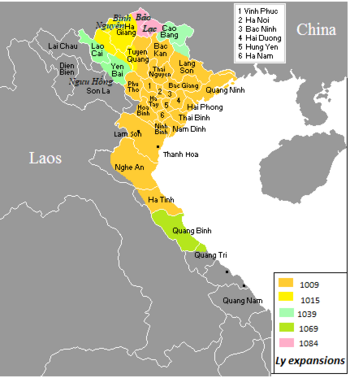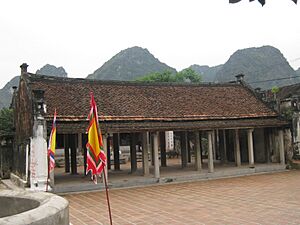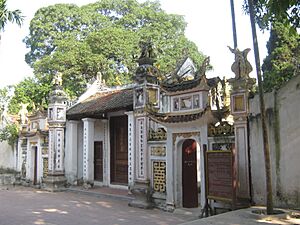Early Lê dynasty facts for kids
Quick facts for kids
Great Cồ Việt
大瞿越國
Đại Cồ Việt Quốc |
|||||||||
|---|---|---|---|---|---|---|---|---|---|
| 980–1009 | |||||||||

Early Lê's territory
|
|||||||||
| Status | Internal imperial system within Song tributary | ||||||||
| Capital | Hoa Lư | ||||||||
| Common languages | Archaic Vietnamese Literary Chinese |
||||||||
| Religion | Vietnamese folk religion Buddhism |
||||||||
| Government | Monarchy | ||||||||
| Emperor | |||||||||
|
• 980–1005
|
Lê Đại Hành (first) | ||||||||
|
• 1005
|
Lê Trung Tông | ||||||||
|
• 1005–1009
|
Lê Ngọa Triều (last) | ||||||||
| Chancellor | |||||||||
|
• 980
|
Hồng Hiến | ||||||||
| History | |||||||||
|
• Emperor Taizong of Song dispatched army to invade Đại Cồ Việt
|
June 980 | ||||||||
|
• Empress Dương Vân Nga enthroned Lê Hoàn
|
980 | ||||||||
|
• Battle of Bạch Đằng (981)
|
980–981 | ||||||||
|
• Lê Ngọa Triều murdered and stole the throne from Lê Trung Tông
|
1005 | ||||||||
|
• Death of Lê Ngọa Triều
|
1009 | ||||||||
| Currency | Copper-alloy cash coins | ||||||||
|
|||||||||
| Today part of | Vietnam China |
||||||||
| Early Lê |
|||
|---|---|---|---|
| Country: | Đại Cồ Việt (Vietnam) | ||
| Titles: |
|
||
| Founder: | Lê Hoàn | ||
| Final Ruler: | Lê Ngọa Triều | ||
| Founding Year: | 9th century | ||
The Early Lê dynasty, also known as the Former Lê dynasty, was a ruling family in Vietnam. They ruled the country, then called Great Cồ Việt, from 980 to 1009. This dynasty came after the Đinh dynasty and was followed by the Lý dynasty. Only three emperors ruled during this time.
Contents
How the Early Lê Dynasty Began
After Emperor Đinh Tiên Hoàng and his oldest son were killed, his young son, Đinh Phế Đế, became emperor at just six years old. A general named Lê Hoàn became his helper, or regent. Some people at the court worried that Lê Hoàn might try to take power. So, they tried to overthrow him, but they failed and were executed.
In 980, the Song dynasty of China planned to invade Đại Cồ Việt. Since the young emperor was too small to lead the country in war, the court officials and Empress Dương Vân Nga decided to make Lê Hoàn the new emperor. Most agreed, so the empress removed her own son from the throne and gave the crown to Lê Hoàn. He accepted and started a new ruling family, the Early Lê dynasty. Lê Hoàn is often called Lê Đại Hành.
Lê Đại Hành: A Strong Leader (980–1005)
Lê Đại Hành quickly got ready for war against the Song dynasty. At the Battle of Bạch Đằng River, his army stopped the Song forces. After the battle, Lê Đại Hành sent people to China to make peace. Đại Cồ Việt agreed to send gifts and show respect to the Chinese emperor each year to keep the peace.
In 982, Lê Đại Hành led his army south to attack Champa, a country near Đại Cồ Việt. His army defeated the Champa forces. The Champa king was killed, and their capital city was captured. In 983, the new Champa king agreed to become a friendly state to Đại Cồ Việt.
Back home, Lê Đại Hành worked to improve the country. He built new structures and encouraged farming and crafts to help the economy grow. His government set a good example for future rulers. Lê Đại Hành died in 1005 when he was 65 years old, after ruling for 25 years. He wanted his youngest son, Lê Long Việt, to be the next emperor.
Challenges to the Throne
Lê Long Việt's Short Reign (1005)
Lê Hoàn had chosen his first son, Lê Long Thâu, to be the next emperor early in his rule. But Lê Long Thâu died in 1000. Lê Hoàn then had to pick another heir.
His fifth son, Lê Long Đĩnh, wanted to be the next emperor. Some thought Lê Hoàn favored him. However, court officials suggested choosing an older son, Lê Long Việt. Lê Hoàn listened to their advice and chose Lê Long Việt.
After Lê Hoàn died in 1005, his sons fought over who would rule. This fight lasted for eight months. In late 1005, Lê Long Việt defeated his brother Lê Long Tích. Lê Long Việt then became Emperor Lê Trung Tông. But just three days later, his brother Lê Long Đĩnh killed him and took the throne.
Lê Long Đĩnh's Rule (1005–1009)
Lê Long Đĩnh used his military power to defeat his other brothers and secure his rule. He worked to improve relations with the Song dynasty in China, using a friendly approach. He also strongly supported Buddhism and brought Chinese Buddhist texts to Vietnam.
He focused on the country's economy and built bridges, roads, and other ways to make travel and trade easier. In 1009, he set up trade with the Song dynasty at the border.
The Lying Emperor
Lê Long Đĩnh was known for a health problem that made it hard for him to sit on his throne. He often had to lie down while ruling. Because of this, people called him Lê Ngọa Triều, which means "the one who rules while lying down."
The End of the Early Lê Dynasty
Even with some achievements, ancient records say Lê Long Đĩnh's rule was not very good. Because of his poor health, much of the real power was held by a man from the Lý family, Lý Công Uẩn. People were unhappy with the emperor.
After Lê Long Đĩnh died, the court officials and Buddhist monks agreed to make Lý Công Uẩn the new emperor. This ended the Early Lê Dynasty. The new Lý dynasty brought a new era to Vietnam, blending ideas from both Confucianism and Buddhism.
Life in the Early Lê Dynasty
Government and Administration
The Early Lê dynasty kept many of the government ideas from the Đinh dynasty. However, they made some changes. In 980, Lê Hoàn gave specific jobs to different officials. For example, Hồng Hiến became the grand chancellor, and Phạm Cự Lạng became the vice-chancellor.
A big change was giving different officials specific duties and powers. This was different from the Đinh dynasty, where the emperor held almost all the power.

Dealing with Rebellions
During the Early Lê dynasty, emperors often faced small revolts from local leaders, especially in far-off areas. They had to send armies to stop these uprisings.
For example, in 980, Lê Đại Hành sent an official to collect taxes from two provinces. But this official rebelled and tried to give the provinces to the Kingdom of Champa. Champa refused, wanting to stay friends with Đại Cồ Việt. Lê Đại Hành led his army, defeated the rebel, and took back control. There were more than ten such rebellions during just five years of his rule.
Transportation and Trade
After defeating Champa in 983, Lê Đại Hành added the new land to his country. He started building more roads from the south to Quảng Bình Province. In 1003, he ordered the cleaning of a canal to improve water travel.
By 1009, the country began building many roads and waterways. This helped people and goods move around easily. It also made it simpler for soldiers to travel south.
The main trading partner for Đại Cồ Việt was China. Both countries agreed to set up places for trade along their borders. Local officials also supported trade within the country. Đại Cồ Việt even had officials who helped solve trade disagreements. Vietnam exported valuable items like gold, silver, and bronze.
Economy and Taxes
The Early Lê dynasty collected taxes based on land ownership.
- A public benefit tax required ten days of work for public projects.
- A household tax was paid yearly based on property.
- A military tax was added to the household tax to support the army.
These taxes were often paid with goods, not money. The government also encouraged trade by not taxing traders' property, except for land they owned.
Farming and Land
Farming was very important to the economy. Most village land belonged to the emperor. Land was divided into four types:
- Emperor's land: This land was farmed by prisoners and peasants, and all the crops went to the emperor. Lê Đại Hành started this in 987.
- Distributive land: This land was given to officials or princes as a reward for their service. It was not private property and returned to the emperor when the owner died.
- Religious land: This land was set aside for Buddhist monks.
- Private land: This land could be owned and sold freely by individuals.
The government also encouraged people to settle and farm wild, unused land. This helped expand the country's influence. Peasants shared land equally and paid regular taxes to the government.
Culture and Religion
We don't have many details about the culture during the Early Lê dynasty. However, we know that Buddhism was the most popular religion. It was influenced by the strong Buddhist traditions in China's Tang dynasty. Buddhist monks were highly respected and even helped with government decisions and national planning.
Relations with Other Countries
With the Song Dynasty (China)
During the Early Lê dynasty, Đại Cồ Việt was a tributary state of the Song dynasty. This meant they sent gifts and showed respect to China, which helped keep peace while Đại Cồ Việt remained independent.
After a failed invasion in 981, the Song emperor accepted Lê Hoàn as the ruler of Đại Cồ Việt. However, the Chinese still saw him as a regional military governor, not a full emperor.
Between 982 and 994, Lê Hoàn sent five groups of diplomats to China to ask for official titles. In 986, the Song emperor gave Lê Hoàn the title of "Superior Prefect of Annam." Later, in 993, the Song emperor gave him the title "King of Giao Chi," believing he would remain loyal.
With Champa
The relationship between Đại Cồ Việt in the north and Champa in the south was often difficult. In 981, Lê Đại Hành sent a diplomat to Champa, but the Cham people captured him. This event led to a war between the two countries.
In 982, Lê Hoàn led a successful campaign against Champa. He killed the Cham king and captured their capital city. His army took valuable items like gold and silver and burned down Cham fortresses and tombs. In 992, the new Champa king asked Đại Cồ Việt to release 360 Cham prisoners.


